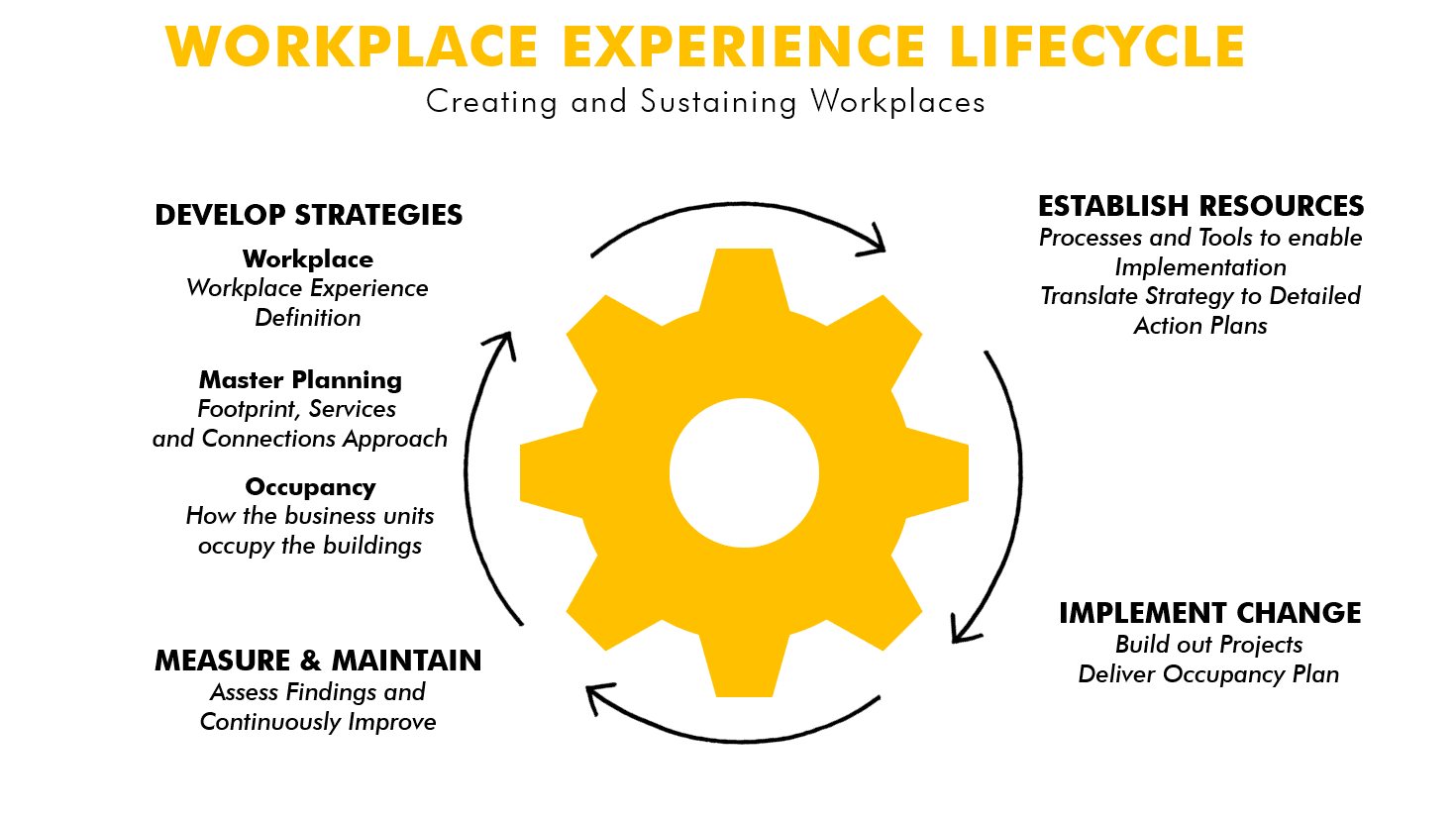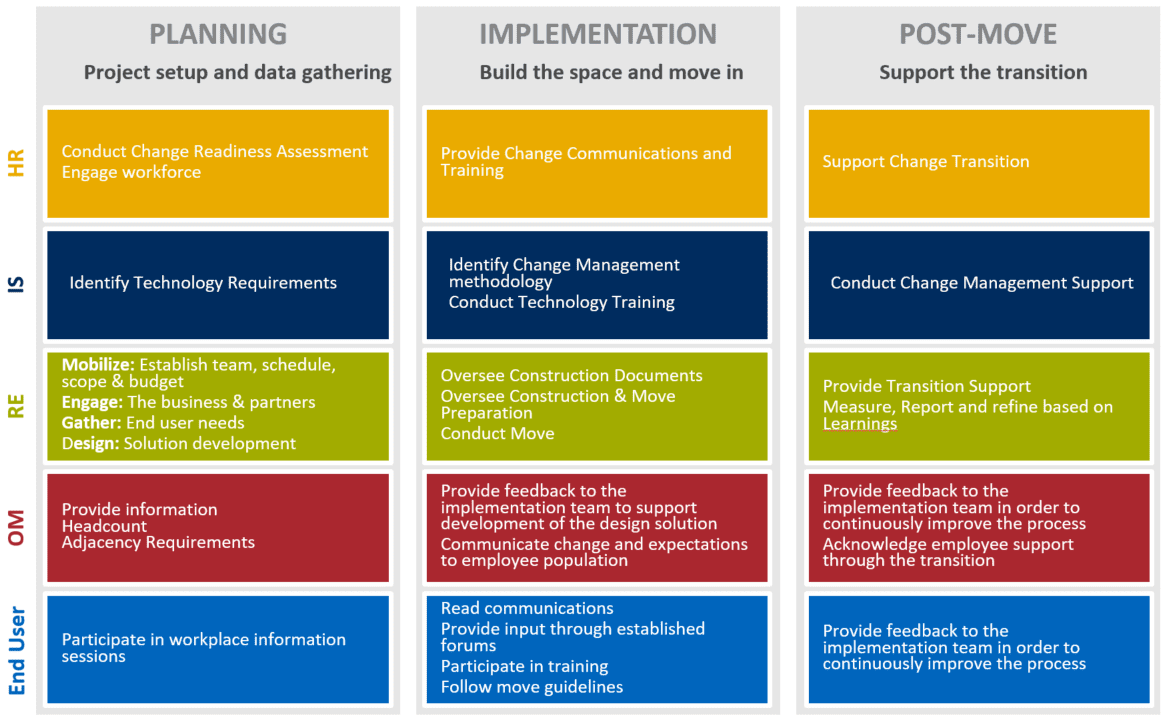By Tish Kruse | Senior Director of Workplace Strategy
September 26th, 2018
More...
A definitive mindset shift is underway—more companies are not only recognizing the value of the key role the workplace plays in enabling the workforce, they are also investing in environments with budgets reshaped in alignment with that value. What are some of the best ways in which companies can allocate funds to realize the highest value for making great places to work? We believe an effective process to develop and deliver workplaces provides significant lasting value when developing environments across an enterprise.
Creating engaging workplaces across an enterprise takes a concerted effort on the part of those who have that responsibility. Once these workplaces are built, it takes a different kind of effort to keep them viable over the course of time. And for companies that have multiple locations in a variety of geographies the approach and process to making change is crucial to success.
When embarking on an initiative to change the workplace(s) for an organization, where do you start? What are the resources that are needed? How do you make it real? At IA, we call the system of making and sustaining change the Workplace Experience Lifecycle. The following is a primer on the basics for creating and maintaining work environments using that system.

1. Develop Strategies
There are three major components to this initial part of the lifecycle.
The first is the workplace strategy, which defines the workplace experience aligned with the business for employees and visitors. It incorporates an integrated approach to place, technology, practices, processes, protocols, and services. Workplace strategy is often best accomplished sans consideration of the building or buildings—the focus is purely on the experience.
Second is the master planning strategy, which considers how the building(s) location, attributes, and space supply support the workplace strategy. The master planning strategy takes the workplace strategy and applies it to the physical reality of the building(s) from a high level and addresses a range of questions such as: Where should we be located? What kind of buildings support our strategy? Do we want to own or lease? How many buildings do we need? And for buildings that are near to each other, there are additional questions: How do we distribute services across buildings? What are the connection points between the buildings?
Lastly is the occupancy strategy, which captures business unit headcount and translates it into space demand based on the principles defined by the workplace strategy. As the master plan tells us generally how much overall space we need across the portfolio, occupancy planning then sorts it by business unit level.
Developing these three interlinked strategies provides the foundation that aligns the strategic approach to the business. It establishes and documents why we are doing this. The end result is a holistic strategy that addresses how to approach the work environment, and how the building(s) work independently and together, as well as the target occupancy for the facilities.

Above is an example of output regarding workplace framework from a workplace experience lifecycle project for a confidential.
2. Establish Resources
Once an overarching plan for the end state is established, how do you begin to make progress? Establishing resources is about providing repeatable processes and tools to ensure the smooth and consistent delivery of the changes made by implementation team members. Guidelines and standards are often the first resources that come to mind. These can range from a succinct set of principles to an expansive set of detailed instructions to design and build the work environment. Whether directional or prescriptive or a mix of both, they convey the established givens to jump start the design process.
Delineation of the implementation process is another useful resource. Process plays a significant role as it defines the order of work, the decisions that need to be made and by whom, and the expected deliverables. Understanding team member roles and responsibilities and how the team works together seems like common sense and it is, but it is often overlooked or not addressed with as much importance as it should be.
Additionally, a significant resource is documentation of the change management process and materials to help facilitate the transition with the workforce. It is commonplace these days to have change management go hand-in-hand with the design process, and the more integration between the two leads to better outcomes.
Lastly, another primary resource is the actual development of an implementation plan over a defined time period. While capital planning is most often done on a yearly basis, an overall implementation plan identifies a likely allocation of the available resources based on a set of criteria. A complementary assessment tool can help vet the plan annually to determine the spend priority.
3. Implement Change
Now it’s time to make the strategy a reality. The implement change category is fundamentally about designing and delivering the strategies to leverage the established resources in creating new work environments. Of course, for the majority of our clients implementing change doesn’t happen all at once—it occurs at intervals over years. With the benefit of time, lessons learned are captured so that the next iteration is better and responsive to ongoing changes in the business. Which leads us to the next category.
4. Measure and Maintain
Many companies we work with say they could do better, a lot better, in this category. Capturing lessons learned, whether the focus is a whole new workspace or an aspect of a work environment, is an opportunity to see how well the solution closed the gap. What aspects should continue? What should be adjusted? What should be added?
Seeking feedback from the users is insightful—whether through surveys or focus groups. There are also considerably more ways to measure how a space is used given the proliferation of new technologies, many at a price point worthwhile to use on a long-term basis. Listening and gathering data subsequent to the shift and then in an ongoing manner making adjustments based on the data ensures the workplace continues to provide the right experience for the workforce.
We’ve outlined the ideal steps in creating a great workplace intentionally as a cycle because it is by nature iterative. Revisiting the strategies on a regular basis, updating the resources, and capturing what is learned from making the changes are all key to keeping the workplace relevant to the workforce. Organizations that adopt a workplace experience life cycle system can go a long way toward realizing a significant, positive impact on the ease with which change is made and ultimate positive outcomes are achieved.
What's the best process for monitoring and adapting workspace so that it stays ahead of the curve? Start with the Workplace Experience Lifecycle.


